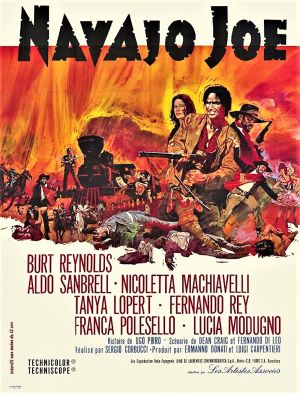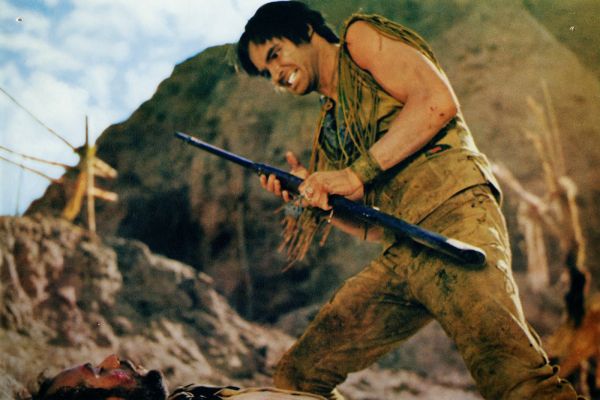Navajo Joe film review (Varied Celluloid)
The Plot: Duncan (Aldo Sambrell) is a ruthless monster who has been working in-between the law for years. He was originally tasked with hunting down Natives who were considered to be outlaws, but eventually his ire was drawn towards any Native American village that he crossed. After ruthlessly massacring another group of Native Americans, Duncan heads into town with the goal of selling off their scalps. However, he finds opposition with the city council who no longer want Duncan’s help. After bullying the citizenry for a bit, Duncan is presented a much more interesting opportunity. A man named Lynne (Peter Cross) sells out the mayor of his neighboring town and tells Duncan of a train which is supposed to be bringing a substantial grant for this neighboring city. Joe (Burt Reynolds), a very tough Native who has been watching Duncan, quickly catches up with a group of prostitutes who have heard the details behind Lynne and Duncan’s plan. However, will Joe do what is right or is he only out to line his own pockets?
The Review
Sometimes as genre movie fans we become so obsessed with searching out the rarities that we can sometimes forget to give our time to the most influential titles that have helped define these genres. Navajo Joe is certainly one such film for me. While I have known about the movie for numerous years, I unfortunately never sought it out until recently. Thinking of it as too common, I had put off the movie for a very long period of time. When I first became a fan of spaghetti westerns, my line of thinking was that I might as well dig into the more “interesting” rarities and skip on this Burt Reynolds-starring feature until a later date. However, in doing this, I skipped past one of the very best known movies within the genre. While Navajo Joe isn’t as defining for the genre as something like Django, it is a movie that is incredibly well known. Why is it so well known? Because it truly is THAT good.
Featuring a starting point for its plot that is highly reminiscent of Scalps, Navajo Joe certainly seems to be an influence on Bruno Mattei’s classic western. However, despite the film being about an Indian who is essentially pitted against a man who terrorizes the Native American nations, the character of “Joe” is hardly a do-good’er. He has the same rebellious streak running through him as the majority of Italian westerns did, even if he is quite different from the majority of Spaghetti stars. With Navajo Joe, the movie does deal with a very sensitive topic, and this certainly adds a very unique twist to the movie. Still, after Joe is first introduced in the movie, his character becomes as ambiguous as any other Spaghetti Western anti-hero. Is he fighting for revenge? Money? Or the honor of his people? He never sets himself up as a clear hero, and this is essential to the Spaghetti Western experience.
Speaking of Joe, this wild character is fairly unique in terms of spaghetti western leading men. Not actually showing up until nearly twenty minutes into the movie, Navajo Joe establishes itself as anything except a run-of-the-mill spaghetti western. The fact that Burt Reynolds plays a Native American is still a point of controversy, and this is understandably so. He is obviously not a very convincing Native American in terms of his look, but I will commend the film for not pushing this character with a over-exaggerated stereotypical outfit. As bad as it is to spray-tan Burt Reynolds and throw him in a cloth outfit, the movie could have been so much worse had they dressed him up in full feather-hat regalia. Reynolds’ performance, despite the silly look, is wholly acceptable. He is not in his manic mode that would make him famous, but instead he plays this character with a quiet calm that makes him seem infinitely more dangerous. Not knowing his ambitions until later in the movie, Joe can come across as a very intimidating figure.
The plot is filled with brilliant genre-film staples as well as general movie-logic ridiculousness. For instance, I am a huge fan of the establishing story that focuses on the evil Dr. Lynne and the way the filmmakers introduce a very different sort of “thriller” aspect to the movie, mostly accomplished by keeping Lynne’s appearance hidden until later in the movie. Very smart stuff. As the movie keeps Lynne hidden, it does well by providing only one character who has actually seen his face and knows that he is involved with the nefarious bandit Esperanza. There’s a brilliant reveal where the audience finally discovers just who Lynne is, and the pacing of the movie is taut with a sense of tension. At the same time, however, the movie also shows Esperanza being approached by Lynne only moments before the train, the one that will be robbed, is apparently due to arrive. The timing of these very pivotal moments in the film do not seem to make sense, and it creates a sharp sense of confusion during the course of the movie. As much as I love the way the character of Lynne is introduced, the first forty minutes seem incredibly rushed together and jumbled.
There are continued logical failings on the behalf of numerous characters. During important moments throughout the film, mostly during the latter half, Duncan Esperanza’s crew all act as if they are generally quite belligerent. Unable to figure out ways to question the citizenry of an entire town at their disposal, the movie creates massive gaps that will inevitably lead to a deus ex machina style escape for a captured Joe. Still, this is a western, and such devices are generally par for the course. This sort of stuff truly is expected, but the solid moments all works in favor of the movie instead of allowing the negatives to overtake them. Joe is such an interesting hero and Duncan is such a rotten villain that the movie doesn’t have to try very hard to suck the audience in. With a plot that features numerous subplots that were ahead of their time, Navajo Joe is both a technically savvy little title but also quite intelligent in spite of its silliness. While it may not be the very best from the genre, and can still likely be accused of being racially insensitive (despite Joe being shown as a proper-American who points out the fact that his people pre-date the Westerners within his land), but it is as fun as it has been rumored to be.
The Conclusion
Navajo Joe isn’t a perfect movie, but it does numerous things in a near-perfect manner. With a brilliant pace, Navajoe Joe is incredibly watchable. A guaranteed fun time with several highlights along the way, I definitely recommend readers pick this one up if they haven’t already.I give it a four out of five, but do consider that there are those who would easily consider this to be a perfect-5. A definite must-watch for Spaghetti Western fans.
by Josh Samford, originally published August 2012





